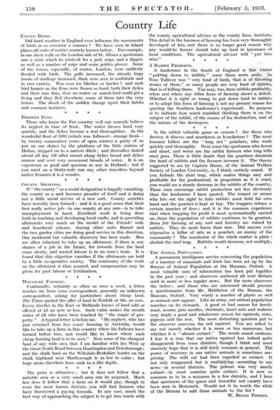THE ANIMAL POPULATION.
A permanent intelligence service concerning the population of a number of mammals and birds has been set up by the Bureau of Animal Population at the Museum, Oxford. A most valuable sum of information has been put together in the past year ; and observers scattered all over Britain send in more or less regular news. But the more observers the better ; and those who are interested should procure a questionnaire from Mr. Middleton of the Bureau, the Museum, Oxford. Very wisely a number of plants as well as animals now appear. Like an army, our animal population marches on its stomach. A good or bad season for beech- mast, acorns, pine needles, chestnuts, hazel nuts and walnuts may imply a good and wholesome season for squirrels, mice, pigeons and the rest. The most disturbing question put to the observer concerns the red squirrel. You are asked to say not merely whether it is more or less numerous, but whether it is " almost extinct." The words sound ominous. I fear it is true that our native squirrel has indeed quite disappeared from some districts, though I think and most sincerely hope that it is still fairly common in general. The power of recovery in our native animals is sometimes sur- prising. The wild cat had been regarded as extinct. It not only reappeared but is multiplying—according to my news—in several districts. The polecat was very nearly extinct—in most counties quite extinct. It is now so common as to be a nuisance in a few districts, and I hear that specimens of the queer and beautiful red variety have been seen in Merioneth. Would not it be worth the while of the Bureau to add these animals to the list ?
W. BEAcu TnomAs.




































 Previous page
Previous page